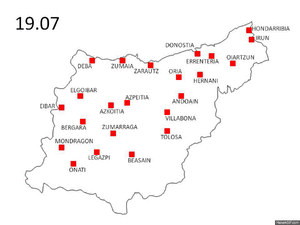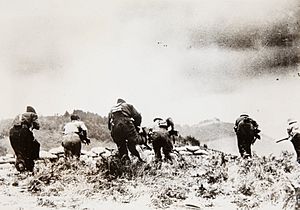Campaign of Gipuzkoa facts for kids
Quick facts for kids Campaign of Gipuzkoa |
|||||||
|---|---|---|---|---|---|---|---|
| Part of the Spanish Civil War | |||||||
 Campaign in one-week intervals |
|||||||
|
|||||||
| Belligerents | |||||||
| Commanders and leaders | |||||||
| Lt. Col. Augusto Pérez Garmendia (POW) (DOW) Lt. Antonio Ortega |
Gen. Emilio Mola Col. Alfonso Beorlegui Canet (DOW) Lt. Col. José Solchaga Lt. Col. Rafael García Valiño |
||||||
| Strength | |||||||
| 3,000 | 3,500 men Ju 52 bombers Italian bombers Panzer I tanks 1 battleship 1 cruiser 1 destroyer |
||||||
| Casualties and losses | |||||||
| ? | ? | ||||||
The Campaign of Gipuzkoa was an important part of the Spanish Civil War. During this time, the Nationalist Army took control of the northern province of Gipuzkoa. This area had been held by the Republic.
Contents
Why the Campaign Started
In July 1936, General Emilio Mola and his troops faced a big problem. They were running low on ammunition. Luckily, Francisco Franco sent them a lot of supplies. These weapons and ammunition came from Italy and Germany.
On August 13, Mola met Franco. They decided to capture the cities of San Sebastián and Irún. Their goal was to cut off the Basque region from the French border. This would stop supplies from reaching the Republic's forces.
The Campaign in Action
Push Towards San Sebastián
General Mola first planned to advance directly to Irún. This would cut off the northern provinces from France. He also wanted to connect with Nationalist soldiers in San Sebastián. These soldiers were supposed to take control of that city.
However, the direct path to Irún was blocked. A bridge at Endarlatsa had been destroyed. Then, Mola heard that the Nationalists in San Sebastián were under attack. They were trapped in the Cuartel de Loyola barracks.
So, General Alfonso Beorlegui Canet changed plans. He moved his forces towards San Sebastián. He hoped to help the trapped Nationalist soldiers. But on July 27, the Nationalist soldiers in San Sebastián surrendered.
Push Towards Irún
After failing to help San Sebastián, Beorlegui's forces went back to their original plan. They continued their advance on Irún. Taking Irún was key to cutting off the northern provinces. These included Gipuzkoa, Biscay, Santander, and Asturias. They needed to stop supplies from France.
On August 11, the Nationalists took Tolosa. Beorlegui also captured Picoqueta. This was a very important ridge that overlooked the path to Irún.
Telesforo Monzón, a Basque Nationalist leader, went to Barcelona for help. He only got 1,000 rifles. The Basque Nationalists also took gold from the local bank. They wanted to buy weapons in France. But on August 8, the French government closed its border. This made it very hard to get supplies.
On August 17, Nationalist warships arrived at San Sebastián. The battleship España, the cruiser Almirante Cervera, and the destroyer Velasco began shelling the city. German Ju 52 bombers and Italian planes also attacked daily. They bombed towns like Hondarribia and Irún. The Nationalists also captured Pérez Garmendia, the Republican commander in Gipuzkoa.
The Fall of Irún and San Sebastián
On August 26, Beorlegui started the main attack on Irún. The Republican and Basque nationalist militias were not well-armed or trained. But they fought bravely. Still, they could not stop the Nationalist advance.
After fierce fighting, the defending forces were overwhelmed. Thousands of civilians and soldiers fled across the French border. This happened on September 3, 1936. The Nationalists took control of Irún that same day. General Beorlegui was wounded during the fighting. He died a month later.
Some retreating Republican soldiers, angry about their lack of ammunition, set parts of Irún on fire. The Nationalists then moved on to capture San Sebastián. They took the city on September 13. General Beorlegui, though dying, was able to see his victorious troops enter the city. There was no more fighting there.
Many people, about 30,000, fled San Sebastián. They were terrified and went towards Biscay. Officials from the Basque Nationalist Party helped people leave safely. They also stopped some groups who wanted to cause more damage.
After the city was taken, many people faced unfair trials and executions. Hundreds of people were killed in the following months. Among them were priests who supported Basque nationalism. The city's mayor was also executed.
The Nationalist forces continued to move west. Republican forces stopped them for a few days at Buruntza. But the Nationalists kept pushing. They reached the edge of Biscay. Here, the Basque pro-Republican forces put up a strong fight. They received 8,000 rifles smuggled in from Santander. The Nationalists were also very tired. This stopped their attack until the War in the North began later.
What Happened Next
The Nationalists gained control of a large area of land and many factories. They also cut off the Basque region from France. This was a big win for them.
After taking San Sebastián, speaking the Basque language was discouraged and later forbidden. The new rulers were very strict. Many people who were seen as a threat were punished. This included Basque priests. They were targeted because of their families or their support for Basque ideas. Many civil servants and railway workers were also removed from their jobs.
One sad event was the killing of José Ariztimuño, also known as 'Aitzol'. He was a priest and an important figure in Basque culture. He was killed on October 18 in a cemetery in Hernani. Other priests and civilians were also killed with him.
See also
 In Spanish: Campaña de Guipúzcoa para niños
In Spanish: Campaña de Guipúzcoa para niños
- List of Spanish Nationalist military equipment of the Spanish Civil War
- List of Spanish Republican military equipment of the Spanish Civil War
- The Basques during wartime
Sources
- Romero, Eladi, Itinerarios de la Guerra Civil española : guía del viajero curioso, Barcelona : Laertes, 2001, 600 p.
- Barruso, Pedro, Verano y revolución. La guerra civil en Gipuzkoa' (julio-septiembre de 1936), Edita: Haramburu Editor. San Sebastián, 1996.
- Pedro Barruso, GIPUZKOA 1936: VERANO Y REVOLUCIÓN, LA GUERRA CIVIL EN GIPUZKOA (Spanish)
- Manuel Aznar Historia Militar de la Guerra de España. 3 vols. Madrid: Editora Nacional, 1969.
Original date, 1938.


